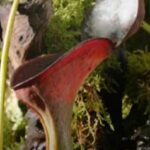As an Amazon Associate, this site earns commissions from qualifying purchases. For more details, click here.
One of the most common questions about pitcher plants is if they can photosynthesize and contain chlorophyll just like other plants. Because if these plants can manufacture their own food, what is the point of eating bugs? It is a good question and the answer will be explained in detail here. As you will see, nepenthes are different from the typical houseplant, but they also share some common features.
Pitcher plants have chlorophyll and use photosynthesis to produce glucose, a sugar-type substance that serves as food. But they still need insects to get nutrients such as nitrogen, which is lacking in the soil.
Do Pitcher Plants Do Photosynthesis?
Chlorophyll is a pigment which gives plants their green color. All pitcher plants have chlorophyll and it is one of the ingredients used for photosynthesis.
Photosynthesis enables plants to create glucose, their food. During photosynthesis there are three elements at work; water, carbon dioxide and sunlight.
The plant takes carbon dioxide from the atmosphere and water off the soil, and they are stored in the plant cells. A transformation takes place where carbon dioxide is converted into glucose and water is turned into oxygen.
The oxygen is released into the atmosphere while glucose is kept in the plant. Chlorophyll is found in plant cells inside the chloroplast. Plants appear green because green light waves are reflected and the red and blue light waves are absorbed.
Chlorophyll allows pitcher plants to store energy and resources required to grow tissues. However their main function is to absorb sunlight. This can also work indoors if you use grow lights such as GE Grow LED Light Bulbs.
Pitcher plants depend on glucose to produce leaves, traps, nectar (the sweet substance used to lure prey), roots, and other parts. However glucose alone is not enough. Additional nutrients are needed to keep the plant growing and stay healthy. Because pitcher plants cannot survive in rich soil, they depend on insects for these elements.
Can Pitcher Plants Live on Chlorophyll and Photosynthesis?
It is true that some pitcher plants can live on light, water and air alone. But plants that are well fed live longer and are healthier. Insects like flies, crickets, gnats and moths provide additional nutrients that complement glucose.
Non-carnivorous plants do not live off photosynthesis alone. They require nutritious soil to survive. Without the nitrogen in the soil, these plants will quickly perish.
There have been cases where pitcher plants have survived without being fed any insects. It is true that the right setting reduces the need for frequent feeding. But if you stop feeding the plant, its growth will slow and possibly stop. Its traps will become fewer and smaller too.
If you are going to grow pitcher plants, it is best to give them access to food. Hanging pitcher plants outdoors means you do not have to do any feeding. Its nectar will do the job and attract prey. Just check its pitchers every now and then and you should see bugs there.
Why Pitcher Plants Eat Insects
Indoor plants should be fed at least once a month. Aside from insects you can give them fish pellets and food like Tetra Freeze Dried Bloodworms. Place a few of these into a pitcher and in time the plant will eat them. It is all right to feed just one pitcher a month (or a week).
Plants rely on photosynthesis for food, but they also get nutrients and other elements from the soil. Glucose functions as food while nitrogen, phosphorus, calcium etc. serve as nutrients.
Pitcher plants require nutrients as much as any plant, but they can only use those that come from insects caught in their traps. Carnivorous plants, including nepenthes and sarracenia, will perish if planted in rich, fertilized soil.
This is why you have to use the right soil for pitcher plants. Even if there is plenty of sunlight, water and humidity, the wrong potting media can cause harm.
Pitcher plants use their pitchers to trap and eat insects. When a bug is digested, it is turned into nutrients and used to supplement glucose. It is similar to how non-carnivorous plants use nitrogen and other elements in the soil.
These nutrients are used to create more traps, leaves, liquids for the pitchers, nectar, digestive enzymes and more. Plants also store energy in their cells and use it to fortify their immune system against diseases.
What if You Grow Pitcher Plants in Rich Soil?
Pitcher plants cannot process nutrients in the soil. They are accustomed to growing in poor media. Fertilized grounds are fatal.
Growing nepenthes in rich media will overwhelm the plant with nutrients. Imagine if its pitchers catch several bugs and digest them. The plant absorbs the nutrients it needs and stores them as energy.
If you use nutritious soil the plant will suffer serious damage. The presence of nitrogen and other elements will cause a shock to the system and affect its daily activities.
If you have ever repotted a plant, you may have seen some leaves turn brown or refuse to eat. This is due to stress as the plant is trying to get over the shock of being in a new home. This is magnified if you plant it in rich soil. In this case, it could kill your nepenthes outright.
Plants get minerals and nutrients from the soil, as they are coursed through its roots. But carnivorous plants live in bogs where water has washed away most, if not all these nutrients. So these plants have to eat insects because they contain iron, nitrogen, calcium and other elements.
Pitcher plants have fully adapted to this environment so much that they cannot live in rich soil. And growing in poor soil provides pitcher plants with additional benefits. Very few plants grow there so they can have the environment to themselves.
So while the soil they live in does not have nutrients, they can get it from insects. Combined with photosynthesis and chlorophyll, these plants will thrive.
Tips For Growing Pitcher Plants
Pitcher plants are actually easy to grow if you know their requirements. Problems arise when they are treated like regular houseplants since their needs are quite different.
- Provide as much light as possible. Nepenthes needs at least 6 hours of light every day, preferably 8. Sarracenia needs even more light than nepenthes. While nepenthes can grow indoors with artificial light, sarracenia prefer outdoors.
- You can tell from the plant color if they are healthy or not. Pitcher plants with vibrant colors are getting the light, water and humidity they need. If the plant starts losing its colors, it is not receiving enough light, water or both.
- While pitcher plants need sunlight for photosynthesis, too much can be harmful. Excessive heat can dry out the pitchers and make it impossible for them to eat prey. High temperatures can also burn leaves.
- Water these plants from the top. It is more effective than the tray method.
- Never give large animals like rats to pitcher plants. The plant might not have enough energy to do this and the animal could rot inside the pitcher.
- Sarracenia plants can handle more heat and water than nepenthes. Be generous with water during hot days.
You do not need to be an expert in chlorophyll and photosynthesis to nurture pitcher plants. But basic knowledge does help when it comes to managing the plants and knowing what to expect.
As has been explained here, pitcher plants are capable of making their own food. Through photosynthesis and chlorophyll they generate glucose. But glucose is not enough. Plants also use nitrogen and other elements to supplement glucose.
Nitrogen comes from the soil, but because pitcher plants grow in bogs these nutrients have already dissipated. So they rely on insects for their nutritional requirements. Once you know these facts, it is easy to see how the two complement one another.
Conclusion
These types of questions are important for anyone who wants to grow pitcher plants, or any carnivorous plant. Knowing their behavior, habitat and requirements will make the difference when it comes to growing and propagating nepenthes and sarracenia.

My fascination with carnivorous plants began many, many years ago with Venus Fly Traps. Now I am more than happy to impart what I know with other enthusiasts and those who are curious about meat eating plants.



